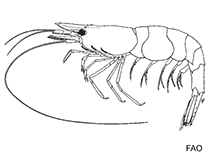Atyoida bisulcata Randall, 1840
Mountain opae
Upload your photos
Google image | No image available for this species;
drawing shows typical species in Atyidae.
Google image | No image available for this species;
drawing shows typical species in Atyidae.
Classification / Names Common names | Synonyms | CoL | ITIS | WoRMS
Malacostraca | Decapoda | Atyidae
Environment: milieu / climate zone / depth range / distribution range Ecology
Benthic; freshwater. Tropical
Distribution Countries | FAO areas | Ecosystems | Occurrences | Introductions
Endemic to Hawaii.
Length at first maturity / Size / Weight / Age
Maturity: Lm ? range ? - ? cm
Excellent climbers found in upper parts of clean and unaltered streams, often in fast water, clinging to boulders and rocks. Catches plant and animal matter in the running water with hairy modified pincers. Fed on by native and introduced fish species as well as crayfish and Tahitian prawns, as well as birds (black crowned night heron and wandering tattler). Lay eggs that hatch and flow down to the ocean. Larvae stays in the ocean for a few months and migrate to streams where they become adults. May travel as far upstream reaching 3,000 feet of elevation (Ref. 84067).
Life cycle and mating behavior Maturity | Reproduction | Spawning | Eggs | Fecundity | Larvae
Members of the order Decapoda are mostly gonochoric. Mating behavior: Precopulatory courtship ritual is common (through olfactory and tactile cues); usually indirect sperm transfer.
Main reference
References | Coordinator | Collaborators
Bisby, F.A., M.A. Ruggiero, K.L. Wilson, M. Cachuela-Palacio, S.W. Kimani, Y.R. Roskov, A. Soulier-Perkins and J. van Hertum. 2005. (Ref. 19)
IUCN Red List Status (Ref. 130435)
Near Threatened (NT) ; Date assessed: 23 November 2011
CITES status (Ref. 108899)
Not Evaluated
CMS (Ref. 116361)
Not Evaluated
Threat to humans
Harmless
Human uses
Fisheries: subsistence fisheries
| FishSource |
Tools
More information
Age/Size
Growth
Length-weight
Length-length
Morphology
Larvae
Abundance
Growth
Length-weight
Length-length
Morphology
Larvae
Abundance
Internet sources
BHL | BOLD Systems | CISTI | DiscoverLife | FAO(Publication : search) | Fishipedia | GenBank (genome, nucleotide) | GloBI | Gomexsi | Google Books | Google Scholar | Google | PubMed | Tree of Life | Wikipedia (Go, Search) | Zoological Record
Estimates based on models
Price category
(Ref. 80766):
Unknown.



